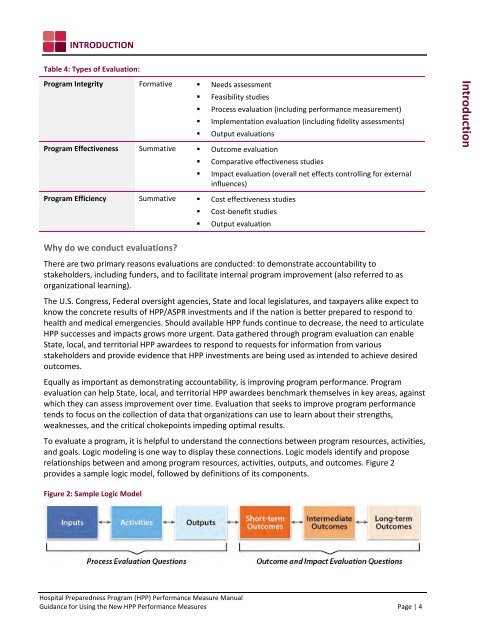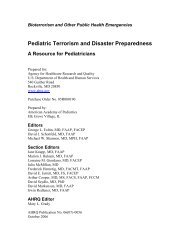(HPP) Performance Measure Manual
(HPP) Performance Measure Manual
(HPP) Performance Measure Manual
Create successful ePaper yourself
Turn your PDF publications into a flip-book with our unique Google optimized e-Paper software.
INTRODUCTION<br />
Table 4: Types of Evaluation:<br />
Program Integrity Formative • Needs assessment<br />
• Feasibility studies<br />
• Process evaluation (including performance measurement)<br />
• Implementation evaluation (including fidelity assessments)<br />
• Output evaluations<br />
Program Effectiveness Summative • Outcome evaluation<br />
• Comparative effectiveness studies<br />
• Impact evaluation (overall net effects controlling for external<br />
influences)<br />
Introduction<br />
Program Efficiency Summative • Cost effectiveness studies<br />
• Cost-benefit studies<br />
• Output evaluation<br />
Why do we conduct evaluations?<br />
There are two primary reasons evaluations are conducted: to demonstrate accountability to<br />
stakeholders, including funders, and to facilitate internal program improvement (also referred to as<br />
organizational learning).<br />
The U.S. Congress, Federal oversight agencies, State and local legislatures, and taxpayers alike expect to<br />
know the concrete results of <strong>HPP</strong>/ASPR investments and if the nation is better prepared to respond to<br />
health and medical emergencies. Should available <strong>HPP</strong> funds continue to decrease, the need to articulate<br />
<strong>HPP</strong> successes and impacts grows more urgent. Data gathered through program evaluation can enable<br />
State, local, and territorial <strong>HPP</strong> awardees to respond to requests for information from various<br />
stakeholders and provide evidence that <strong>HPP</strong> investments are being used as intended to achieve desired<br />
outcomes.<br />
Equally as important as demonstrating accountability, is improving program performance. Program<br />
evaluation can help State, local, and territorial <strong>HPP</strong> awardees benchmark themselves in key areas, against<br />
which they can assess improvement over time. Evaluation that seeks to improve program performance<br />
tends to focus on the collection of data that organizations can use to learn about their strengths,<br />
weaknesses, and the critical chokepoints impeding optimal results.<br />
To evaluate a program, it is helpful to understand the connections between program resources, activities,<br />
and goals. Logic modeling is one way to display these connections. Logic models identify and propose<br />
relationships between and among program resources, activities, outputs, and outcomes. Figure 2<br />
provides a sample logic model, followed by definitions of its components.<br />
Figure 2: Sample Logic Model<br />
Hospital Preparedness Program (<strong>HPP</strong>) <strong>Performance</strong> <strong>Measure</strong> <strong>Manual</strong><br />
Guidance for Using the New <strong>HPP</strong> <strong>Performance</strong> <strong>Measure</strong>s Page | 4
















